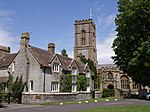Burton Pynsent House
Burton Pynsent House is a historic country-house in the parish of Curry Rivel, Somerset, England. It is a Grade II* listed building. The house was built in stages between 1565 and 1765, when it was bequeathed to William Pitt, 1st Earl of Chatham by Sir William Pynsent, 2nd Baronet, who did not want the house to go to Lord North. Pitt had an additional wing built to a design by Lancelot Brown, and the subsequent owner demolished everything but this wing in 1805. The house was extended around this wing in the 20th century, overlooking the 98 hectares (240 acres) of formal gardens and parkland. To the northwest of the house is Burton Pynsent Monument, a 140 feet (43 m) column with an urn finial, built to commemorate Pynsent's generosity to Pitt.
Excerpt from the Wikipedia article Burton Pynsent House (License: CC BY-SA 3.0, Authors).Burton Pynsent House
A378,
Geographical coordinates (GPS) Address Nearby Places Show on map
Geographical coordinates (GPS)
| Latitude | Longitude |
|---|---|
| N 51.015833333333 ° | E -2.8944444444444 ° |
Address
A378
TA10 0PF
England, United Kingdom
Open on Google Maps








